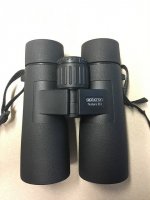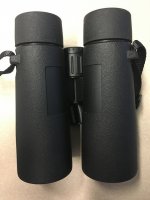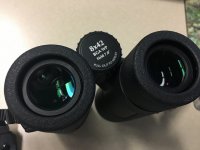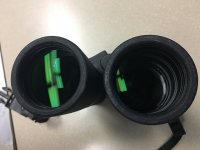FrankD
Well-known member
Introduction:
I have been putting off my review of the new Opticron Natura ED models for the last four or five months for a few reasons. For one, as I mentioned in my previous post, life has been busy on my end and I just haven’t had the time to sit down and do the reviews that various binoculars and spotting scopes deserve. Two, I received several other new models to use and review in the mean time. Lastly, I used both the 8x32 and 8x42 extensively once I received them but that was several months ago and I wanted to use them again now so I could fresh impressions instead of relying on memory alone.
This review is going to focus on the 8x42 model as I prefer it to the 8x32. That is a bit of a change of pace as I tend to prefer 8x32s in general with one or two exceptions. Their more compact design and generally wider field of view usually trumps any “low light” advantage or exit pupil “comfort” that an 8x42 can provide. In this case though there were two issues that drew me to the 8x42 instead. First I like the size and handling of this particular 8x42 model. The housing is contoured/tapered from the larger object back to the smaller diameter eyecups. Add to that the “shorter conventional bridge” design and my hands just fit around this very naturally. Second, the focus wheel of the 8x32 is stiffer than I prefer for practical use. It has loosened up slightly over time but not to the point that I consider it acceptable.
The current ED version of the Natura binocular has nothing in common with the original Natura that Opticron introduced a few years ago. The original model had a notably narrower field of view, lacked the ED glass of the current model and had an open bridge design.
Now that the introduction is out of the way let’s look at the advertised specifications/features as per the Opticron website:
Features include;
• Compact, lightweight roof prism design with micro hinge body
• Textured rubber armor
• Nitrogen waterproof construction
• ED, fully multi-coated optical system with ‘PC’ phase corrected prisms and Oasis prism coating
• Long eye relief eyepieces giving full field of view for glasses wearers
• Wide wheel focusing with integrated rhs diopter adjuster
• 3-stage alloy retractable eyecups
• Close focus to 7.2ft (8x32), 8.2ft (8/10x42)
• Tripod adapter socket
• Limited Lifetime Warranty
Field of view in feet: 366
Field of view in meters: 122
Close focus distance feet/meters: 8.2 / 2.5
Eye relief in mm: 23
Interpupilary Range: 56~76
Length and width (inches): 5.6x5.1
Length and width (mm)142x129
Weight (ounces/grams) 22.9 / 648
MSRP: $409.00
Ergonomics/Mechanics:
As I mentioned in the introduction I really like the ergonomics of this binocular, especially for a full-sized 8x42 model. The binocular feels light in the hand without feeling flimsy. I believe this is the result of the combination of the relatively light weight (22.9 ounces) and the texturing of the rubber armor. It has a slightly pebbled or dimpled feel to it. I have found this to be both pleasant to the touch and practical in wet weather.
Also mentioned previously is the shorter, conventional hinge design. This design allows more of my fingers to wrap comfortably around the barrel especially in comparison to a normal, conventional hinge design. This then leads to a more stable grip and subsequently a more stable image.
The focusing knob is well placed for my index finger, large enough for my finger to find it and the ribbing across the focusing knob makes sure my finger does not slip off of it accidentally. The diopter adjustment is located on the focusing knob with this model. It is a straight-forward “pull up to adjust, pop-back-in to lock” arrangement. I have not had issues with the diopter accidentally moving with this design.
Focusing tension started out a bit stiff right out of the box but has loosened up to a more than acceptable level. There is still a bit of “stiction” to the feel of the focusing movement but it seems to get less and less with regular use. I wonder if this is related to the diopter adjustment being placed in this location as several binoculars I have owned with this design displayed this feel to some degree.
The binocular close focuses to about 7 feet with my eyes. Focusing direction is counterclockwise and it takes approximately one and 2/5ths turns to go from close focus to infinity with about a quarter turn of travel past infinity focus.
The metal eyecups twist out to adjust effective eye relief. They have three settings: Fully collapsed, intermediate and fully extended. They stay locked at the intermediate and fully extended position thanks to a nifty little mechanism. You actually twist past the intermediate or fully extended position slightly before twisting back down to a locked one.
There are two thumb indents on the underside of the barrel but, as in the last review, they don’t force you into a specific finger/hand position due to the shallow and broad nature of the design. The pictures will illustrate this nicely.
Optical performance:
This binocular provides an interesting blend of optical performance areas. Strong points include excellent CA control over practically the entire field of view, very good apparent sharpness and very good apparent brightness. The only weak spot I have found is an average field of view (366 feet at 1000 yards or 7 degrees). In addition, the sweet spot size appears to be very generous. I would estimate close to 85% of the field of view is as sharp as the center. The next 7-8% is a transitional zone and the last 7-8% is out of focus but snaps into focus with a slight turn of the focusing knob (field curvature).
To be honest I prefer and am accustomed to using 8x binoculars (32 mm or 42 mm) with a wider field of view than this. Most of the ones that I have been using recently sport 8 degrees (420 feet) + fields of view so I do notice the difference when switching to the Natura ED. The strange part is I don’t find it bothersome in the least. This is curious to me as I would expect to feel more restricted as if I was missing out on something. I think that impression relates to the following characteristics.
One, as I mentioned the apparent sharpness is very good. I would even venture to say excellent. I seem to be able to see the smallest details on either the holly bush outside my window (about 15 feet away) or looking all the way out at birds of prey flying over a local ridge close to a mile away.
Two, apparent brightness appears to be very good. My first inclination of this was using the binocular at dusk recently. I could clearly see better with the binocular than with my own eyes. The image in the binocular, under those conditions, just appeared notably brighter. In a second situation I could readily detect color or shades of color on distant raptors. IDing Black Vultures by the small white patches on the wings seemed relatively easy as I could see them clearly even on a cloudy, dreary day.
Third, I have to say that the CA control on this model is very impressive. For those of you that are binocular aficionados out there you know a good ED glass binocular when you get that clean, sharp, crystalline style image. Everything seems almost hyper-real because the image is so clean and sharp. This model displays that level of performance.
Lastly, as I mentioned, the sweet spot size is very generous as I would hope considering the relatively average field of view. I believe the size of the sweet spot, and also the type of distortion/aberrations outside of the sweet spot can lead directly to how relaxed the image is. The image in the Natura ED feels very relaxed and natural. In addition the binocular displays literally no color bias. I have compared it to binoculars that have a slightly warm (either yellow or red/purple) color bias and to my eyes the Natura ED seems neutral in that regard, not favoring the warm or cold area of the visible spectrum.
Summary:
This binocular utilizes a relatively conservative overall design. It does not break any new ground in terms of optical performance. Yet, I thoroughly enjoy using it. Case in point, the last few days have seen a notable fallout of migrating species at the local lake. I have several binoculars always handy in my vehicle when I go out to survey a “birdy” area. The first one I have been grabbing recently is the Natura ED. Its comforable handling and light weight for a full-sized model coupled with its clean and relaxed image have made it a pure pleasure to use. I plan on keeping this one.
I have been putting off my review of the new Opticron Natura ED models for the last four or five months for a few reasons. For one, as I mentioned in my previous post, life has been busy on my end and I just haven’t had the time to sit down and do the reviews that various binoculars and spotting scopes deserve. Two, I received several other new models to use and review in the mean time. Lastly, I used both the 8x32 and 8x42 extensively once I received them but that was several months ago and I wanted to use them again now so I could fresh impressions instead of relying on memory alone.
This review is going to focus on the 8x42 model as I prefer it to the 8x32. That is a bit of a change of pace as I tend to prefer 8x32s in general with one or two exceptions. Their more compact design and generally wider field of view usually trumps any “low light” advantage or exit pupil “comfort” that an 8x42 can provide. In this case though there were two issues that drew me to the 8x42 instead. First I like the size and handling of this particular 8x42 model. The housing is contoured/tapered from the larger object back to the smaller diameter eyecups. Add to that the “shorter conventional bridge” design and my hands just fit around this very naturally. Second, the focus wheel of the 8x32 is stiffer than I prefer for practical use. It has loosened up slightly over time but not to the point that I consider it acceptable.
The current ED version of the Natura binocular has nothing in common with the original Natura that Opticron introduced a few years ago. The original model had a notably narrower field of view, lacked the ED glass of the current model and had an open bridge design.
Now that the introduction is out of the way let’s look at the advertised specifications/features as per the Opticron website:
Features include;
• Compact, lightweight roof prism design with micro hinge body
• Textured rubber armor
• Nitrogen waterproof construction
• ED, fully multi-coated optical system with ‘PC’ phase corrected prisms and Oasis prism coating
• Long eye relief eyepieces giving full field of view for glasses wearers
• Wide wheel focusing with integrated rhs diopter adjuster
• 3-stage alloy retractable eyecups
• Close focus to 7.2ft (8x32), 8.2ft (8/10x42)
• Tripod adapter socket
• Limited Lifetime Warranty
Field of view in feet: 366
Field of view in meters: 122
Close focus distance feet/meters: 8.2 / 2.5
Eye relief in mm: 23
Interpupilary Range: 56~76
Length and width (inches): 5.6x5.1
Length and width (mm)142x129
Weight (ounces/grams) 22.9 / 648
MSRP: $409.00
Ergonomics/Mechanics:
As I mentioned in the introduction I really like the ergonomics of this binocular, especially for a full-sized 8x42 model. The binocular feels light in the hand without feeling flimsy. I believe this is the result of the combination of the relatively light weight (22.9 ounces) and the texturing of the rubber armor. It has a slightly pebbled or dimpled feel to it. I have found this to be both pleasant to the touch and practical in wet weather.
Also mentioned previously is the shorter, conventional hinge design. This design allows more of my fingers to wrap comfortably around the barrel especially in comparison to a normal, conventional hinge design. This then leads to a more stable grip and subsequently a more stable image.
The focusing knob is well placed for my index finger, large enough for my finger to find it and the ribbing across the focusing knob makes sure my finger does not slip off of it accidentally. The diopter adjustment is located on the focusing knob with this model. It is a straight-forward “pull up to adjust, pop-back-in to lock” arrangement. I have not had issues with the diopter accidentally moving with this design.
Focusing tension started out a bit stiff right out of the box but has loosened up to a more than acceptable level. There is still a bit of “stiction” to the feel of the focusing movement but it seems to get less and less with regular use. I wonder if this is related to the diopter adjustment being placed in this location as several binoculars I have owned with this design displayed this feel to some degree.
The binocular close focuses to about 7 feet with my eyes. Focusing direction is counterclockwise and it takes approximately one and 2/5ths turns to go from close focus to infinity with about a quarter turn of travel past infinity focus.
The metal eyecups twist out to adjust effective eye relief. They have three settings: Fully collapsed, intermediate and fully extended. They stay locked at the intermediate and fully extended position thanks to a nifty little mechanism. You actually twist past the intermediate or fully extended position slightly before twisting back down to a locked one.
There are two thumb indents on the underside of the barrel but, as in the last review, they don’t force you into a specific finger/hand position due to the shallow and broad nature of the design. The pictures will illustrate this nicely.
Optical performance:
This binocular provides an interesting blend of optical performance areas. Strong points include excellent CA control over practically the entire field of view, very good apparent sharpness and very good apparent brightness. The only weak spot I have found is an average field of view (366 feet at 1000 yards or 7 degrees). In addition, the sweet spot size appears to be very generous. I would estimate close to 85% of the field of view is as sharp as the center. The next 7-8% is a transitional zone and the last 7-8% is out of focus but snaps into focus with a slight turn of the focusing knob (field curvature).
To be honest I prefer and am accustomed to using 8x binoculars (32 mm or 42 mm) with a wider field of view than this. Most of the ones that I have been using recently sport 8 degrees (420 feet) + fields of view so I do notice the difference when switching to the Natura ED. The strange part is I don’t find it bothersome in the least. This is curious to me as I would expect to feel more restricted as if I was missing out on something. I think that impression relates to the following characteristics.
One, as I mentioned the apparent sharpness is very good. I would even venture to say excellent. I seem to be able to see the smallest details on either the holly bush outside my window (about 15 feet away) or looking all the way out at birds of prey flying over a local ridge close to a mile away.
Two, apparent brightness appears to be very good. My first inclination of this was using the binocular at dusk recently. I could clearly see better with the binocular than with my own eyes. The image in the binocular, under those conditions, just appeared notably brighter. In a second situation I could readily detect color or shades of color on distant raptors. IDing Black Vultures by the small white patches on the wings seemed relatively easy as I could see them clearly even on a cloudy, dreary day.
Third, I have to say that the CA control on this model is very impressive. For those of you that are binocular aficionados out there you know a good ED glass binocular when you get that clean, sharp, crystalline style image. Everything seems almost hyper-real because the image is so clean and sharp. This model displays that level of performance.
Lastly, as I mentioned, the sweet spot size is very generous as I would hope considering the relatively average field of view. I believe the size of the sweet spot, and also the type of distortion/aberrations outside of the sweet spot can lead directly to how relaxed the image is. The image in the Natura ED feels very relaxed and natural. In addition the binocular displays literally no color bias. I have compared it to binoculars that have a slightly warm (either yellow or red/purple) color bias and to my eyes the Natura ED seems neutral in that regard, not favoring the warm or cold area of the visible spectrum.
Summary:
This binocular utilizes a relatively conservative overall design. It does not break any new ground in terms of optical performance. Yet, I thoroughly enjoy using it. Case in point, the last few days have seen a notable fallout of migrating species at the local lake. I have several binoculars always handy in my vehicle when I go out to survey a “birdy” area. The first one I have been grabbing recently is the Natura ED. Its comforable handling and light weight for a full-sized model coupled with its clean and relaxed image have made it a pure pleasure to use. I plan on keeping this one.







